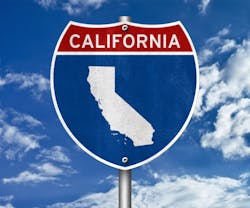Call it progressive, or call it illegal, California continues to go its own way with an ambitious, far-reaching transportation program that is designed to achieve “the next step in the evolution of the freight sector.” So what does the California Sustainable Freight Action Plan mean for trucking?
Broadly, the document lays a foundation for modernizing California’s multi-billion dollar freight transportation system. Developed in response to Governor Brown’s Executive Order B-32-15, which calls for a single integrated action plan for California, the plan was drafted by the California State Transportation Agency, California Environmental Protection Agency, Natural Resources Agency, California Air Resources Board, California Department of Transportation, California Energy Commission and Governor’s Office of Business and Economic Development “with broad stakeholder input.”
The Executive Order directs the state agencies to pursue a shared vision to “improve freight efficiency, transition to zero-emission technologies and increase the competitiveness of California’s freight system.”
The California Trucking Assn. notes that the freight transportation system is responsible for one-third of the state's economy and jobs, with freight-dependent industries accounting for over $740 billion in revenue and over 5 million jobs in 2014—and that the trucking industry has demonstrated its commitment to sustainability.
“Truckers are already spending $1 billion annually to upgrade to cleaner, more efficient equipment, reducing key pollutants by over 90% and virtually eliminating diesel soot,” said CEO Shawn Yadon. “We applaud the Governor’s focus on economic competitiveness and look forward to partnering with the state to ensure that California’s freight system is both sustainable and competitive.”
“Virtually all participants in this process are ‘green groups’ whose intent is transforming society into their own utopian version of how we should all live our lives,” says Joe Rajkovacz, director of governmental affairs for the Western States Trucking Assn. “They make completely specious health affects claims to justify their encroaching into a significant sector of the economy. Trucking is the poster child for everything that is wrong for the environment.”
The plan, in Rajkovacz’s view, is “bureaucratic hubris” backed by enough taxpayer dollars to lure some segments of the industry into supporting goals that, ultimately, will wreck trucking by imposing “fantasy” technologies. The aim is to replace diesel engines not just in port drayage operations, but in long-haul highway freight transportation—where there is no viable alternative. So, depending on the implementation details, trucking and the state will likely have to settle their differences in court.
“The industry has spent approximately $8 billion complying with the current CARB diesel engine regulations—it was never going to be enough,” he says. “No priority is given to expanding the infrastructure as a way to reduce emissions impacts from traffic not being able to move at its most environmentally efficient speeds. That alone shows the sustainable goods strategy is nothing more than ideological.”
Officially, the plan is to improve the efficiency of California’s freight system and reduce its pollution, all the while bolstering the competitiveness of the goods movement system nationally and internationally.
Key components of the Action Plan include:
- a long-term 2050 vision and guiding principles for California’s future freight transport system.
- interim targets as improving freight system efficiency 25 percent by 2030 and deploying more than 100,000 zero-emission vehicles/equipment by 2020; and
- pilot projects, including one to explore “potential incentives for zero and near-zero emission trucks” to achieve concrete progress in the near-term.
“The draft we are releasing today represents an unprecedented collaboration among government agencies, in keeping with the importance of the freight sector to our economy and our environment,” said CARB Chair Mary D. Nichols. “The plan commits to include all stakeholders at every step in the process, from refining goals and selecting pilot projects through implementation into the coming decade. Our challenge is to deliver both public health and economic benefits at our ports, on our highways, and in our communities throughout the state.”
About the Author
Kevin Jones
Editor
Kevin has served as editor-in-chief of Trailer/Body Builders magazine since 2017—just the third editor in the magazine’s 60 years. He is also editorial director for Endeavor Business Media’s Commercial Vehicle group, which includes FleetOwner, Bulk Transporter, Refrigerated Transporter, American Trucker, and Fleet Maintenance magazines and websites.
Working from Beaufort, S.C., Kevin has covered trucking and manufacturing for nearly 20 years. His writing and commentary about the trucking industry and, previously, business and government, has been recognized with numerous state, regional, and national journalism awards.


